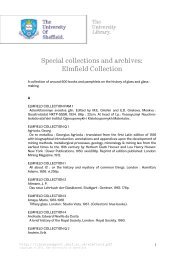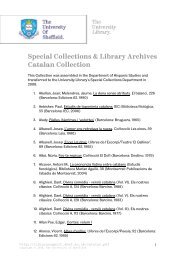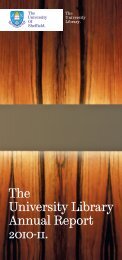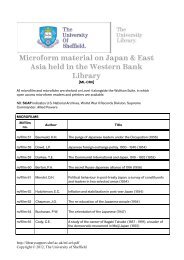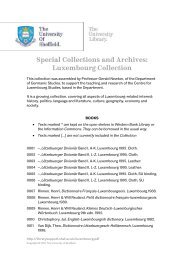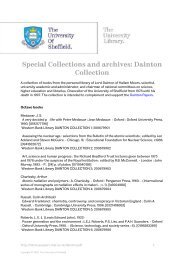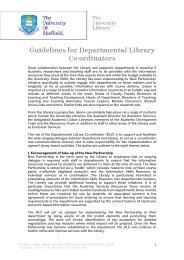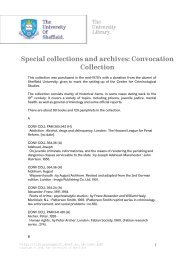The Geoffrey Bullough Collection - Temporary Home Page ...
The Geoffrey Bullough Collection - Temporary Home Page ...
The Geoffrey Bullough Collection - Temporary Home Page ...
Create successful ePaper yourself
Turn your PDF publications into a flip-book with our unique Google optimized e-Paper software.
Second section follows the adventures of a young nobleman Felix as he tries to find a<br />
place in the world.<br />
4. Overview of varieties / dialects<br />
No real varieties represented. Given the interest in varieties in Amaryllis at the Fair<br />
this seems like a deliberate decision. <strong>The</strong> one comment on it comes when Felix<br />
meets a stranger. <strong>The</strong> direct speech of the dialect-speaking stranger is never<br />
represented.<br />
<strong>The</strong> stranger was clad in a tunic, and wore a hat of plaited straw. He was very<br />
tall and strongly built; his single weapon, a spear of twice his own length. His<br />
beard came down on his chest. He spoke to Felix in a dialect the latter did not<br />
understand. Felix held out his hand as a token of amity, which the other took.<br />
He spoke again. Felix, on his part, tried to explain his shipwreck, when a word<br />
the stranger uttered recalled to Felix‘s memory the peculiar dialect used by<br />
the shepherd race in the neighbourhood of his home.<br />
He spoke in the dialect, which the stranger in part at least understood, and<br />
the sound of which at once rendered him more friendly. By degrees they<br />
comprehended each other‘s meaning the easier, as the shepherd had come<br />
the same way and had seen the wreck of the canoe. (p. 178)<br />
Amaryllis at the Fair (pages 199-344)<br />
2. Genre / subgenre<br />
Series of rural scenes<br />
3. Brief synopsis<br />
Not very much structure to it – more just a series of observations about the life of a<br />
young girl (Amaryllis), including her family and potential suitors, with a lot of rural<br />
detail. Amaryllis‘s parents argue, she goes to a fair, offends her wealthy grandfather,<br />
is lusted after by various men, falls in love with a distant cousin who is dying of<br />
consumption. (<strong>The</strong> author himself died of consumption shortly after the publication<br />
of the novel).<br />
4. Overview of varieties / dialects<br />
Third-person narration, frequently focalised through Amaryllis. Amaryllis uses St.E.<br />
but father slips between St.E. and heavily marked rural dialect, and rural dialect is<br />
spoken by peripheral characters. Also a couple of instances of mild representation of<br />
Cockney.<br />
5. Variety #1: un-named rose growers<br />
7a."No call for damask roses – wouldn‘t pay to grow they. Single they was. I thinks.<br />
No good. <strong>The</strong>se be cut every morning and fetched by the flower-girls for gents‘<br />
button-holes and ladies‘ jackets. You won‘t get no damask roses; they be died out.‘ [p.<br />
201]<br />
5b.1 Orthography<br />
None noted<br />
5b.2 Grammar<br />
Non standard conjugation Single they was. I thinks<br />
Non standard to be these be cut, they be died out<br />
Non standard double negatives You won‟t get no damask roses<br />
5b.3 Vocabulary<br />
None noted<br />
5c. Dialect area(s) represented<br />
http://librarysupport.shef.ac.uk /bullough.pdf<br />
Copyright © 2007, <strong>The</strong> University of Sheffield<br />
56








